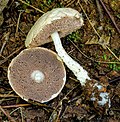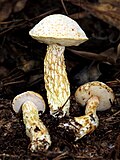Austroboletus
| Austroboletus | |
|---|---|

| |
| Austroboletus eburneus | |
| Scientific classification | |
| Domain: | Eukaryota |
| Kingdom: | Fungi |
| Division: | Basidiomycota |
| Class: | Agaricomycetes |
| Order: | Boletales |
| Family: | Boletaceae |
| Genus: | Austroboletus (Corner) Wolfe (1980) |
| Type species | |
| Austroboletus dictyotus (Boedijn) Wolfe (1980)
| |
| Synonyms | |
| |
Austroboletus is a genus of fungi in the family Boletaceae. The widely distributed genus contains species that form mycorrhizal relationships with plants.
Taxonomy[edit]
E. J. H. Corner originally defined Austroboletus as a subgenus of Boletus in his 1972 work Boletus in Malaysia, before it was raised to genus level in 1979 by mycologist Carl B. Wolfe.[1] The type species is Austroboletus dictyotus, a fungus originally described by Karel Bernard Boedijn in 1960 as a member of the genus Porphyrellus.[2] The generic name Austroboletus means "southern bolete".[3]
In a 2014 molecular genetics study, Wu and colleagues defined 22 clades within the Boletaceae. They found the genus as understood to be polyphyletic – composed of two distinct lineages. One with pitted stipes, which remained as Austroboletus, while those with smoother stipes were moved to Veloporphyrellus. They delineated a subfamily Austroboletoideae, which contained genera with pitted spores, including Austroboletus, Fistulinella, Mucilopilus and Veloporphyrellus. These genera were notable in the family in that their fruit bodies generally do not change colour when bruised.[4]
Description[edit]
Although they resemble other boletes macroscopically, Austroboletus is differentiated microscopically with spores that are pitted, rather than smooth.[5] The spore colour ranges from lilac- or pinkish-brown to wine-coloured.[6] The pores and tubes are whitish.[4] Members of the genus have a distinctive stipe marked by a coarse reticulate or lacunar (pitted) pattern—most prominent in species native to the western Pacific.[6] The caps are usually dry when young, and sometimes sticky in maturity, with a surface texture ranging from smooth to tomentose to scaly. Microscopically, Austroboletus lacks clamp connections in the hyphae, and the presence of pleurocystidia and cheilocystidia (cystidia on the pore face and edge, respectively) is variable.[7]
Habitat, distribution, and ecology[edit]
Members of the genus are found mainly in the tropics, as well as Australia, New Zealand, and New Caledonia in the southern hemisphere and Japan and North America in the Northern Hemisphere.[6] Two species are found in North America: A. gracilis and A. subflavidus.[3] The majority of Austroboletus species form mycorrhizal relationships with plant species.[4]
Species[edit]
As of December 2023[update], Index Fungorum lists 38 valid species in the genus Austroboletus.[8]
| Image | Scientific Name | Taxon author | Year | Distribution |
|---|---|---|---|---|
| A. albidus | Yan C. Li & Zhu L. Yang | 2021 | China (Jiangxi) | |
| A. albovirescens | Yan C. Li & Zhu L. Yang | 2021 | China | |
| A. amazonicus | A.M. Vasco-Pal. & C. López-Quint. | 2014 | Colombia | |
| A. appendiculatus | Semwal, D. Chakr., K. Das, Indoliya, D. Chakrabarty, S. Adhikari & Karun. | 2017 | India | |
| A. asper | K. Syme, Bonito, T. Lebel, Fechner & Halling | 2020 | Queensland | |
| A. austrovirens | N.A. Fechner, Bougher, Bonito & Halling | 2017 | Queensland | |
| A. brunneisquamus | N.K. Zeng, Chang Xu & S. Jiang | 2021 | China | |
| A. cornalinus | (Perr.-Bertr. & R.Heim) E.Horak | 1980 | Gabon | |
| A. dictyotus | (Boedijn) Wolfe | 1980 | China (Hunan) | |
 |
A. eburneus | Watling & N.M.Greg. | 1986 | Queensland |
| A. festivus | (Singer) Wolfe | 1980 | Brazil | |
 |
A. fusisporus | (Kawam. ex Imazeki & Hongo) Wolfe | 1980 | China (Yunnan) |
| A. graciliaffinis | Singer | 1988 | north of Brazil and in Colombia and Venezuela | |
 |
A. gracilis | (Peck) Wolfe | 1980 | Mexico to Costa Rica |
| A. heterospermus | (R.Heim & Perr.-Bertr.) Singer | 1983 | ||
 |
A. lacunosus (Kuntze) | T.W.May & A.E.Wood | 1995 | Australia, New caledonia and New Zealand |
| A. latitubulosus | E.Horak | 1980 | Papua New Guinea | |
| A. malaccensis | (Pat. & C.F.Baker) Wolfe | 1980 | ||
| A. mucosus | (Corner) Wolfe | 1980 | ||
| A. mutabilis | Halling, Osmundson & M.A. Neves | 2006 | northern Australia | |
| A. neotropicalis | Singer, J.García & L.D.Gómez | 1991 | Costa Rica | |
 |
A. occidentalis | Watling & N.M.Greg. | 1986 | Western Australia and southeastern Tasmania |
| A. olivaceobrunneus | Yan C. Li & Zhu L. Yang | 2021 | China | |
| A. olivaceoglutinosus | K.Das & Dentinger | 2015 | India (Sikkim), China (Yunnan) | |
| A. olivaceus | Singer | 1983 | ||
| A. purpurascens | (Heinem.) E.Horak | 1980 | Zaire | |
 |
A. rarus | (Corner) E.Horak | 1980 | Singapore and Australia |
| A. rionegrensis | (Singer & I.J.Araujo) Singer | 1983 | Brazil. | |
 |
A. roseialbus | N.A. Fechner, Bonito, T. Lebel & Halling | 2017 | eastern New South Wales |
 |
A. rostrupii | (Syd. & P.Syd.) E.Horak | 1980 | Thailand, Singapore |
| A. rubiicolor | (Corner) E.Horak | 1980 | Singapore | |
| A. schichianus | (Teng & L.Ling) E.Horak | 1980 | China | |
 |
A. subflavidus | (Murrill) Wolfe | 1980 | United States(New Jersey to Florida and Texas) and Central America |
 |
A. subvirens | (Hongo) Wolfe | 1980 | Japan, Papua New Guinea |
| A. trinitatensis | Wolfe | 1988 | ||
| A. tristis | (Pat. & C.F.Baker) Wolfe | 1980 | ||
| A. viscidoviridis | N.A. Fechner, Bonito, T. Lebel & Halling | 2017 | Queensland | |
| A. yourkae | F.E. Guard, McMull.-Fish., Van Wyk, T. Lebel & Halling | 2021 | Queensland |
References[edit]
- ^ Wolfe CB. (1979). "Austroboletus and Tylopilus subgenus Porphyrellus, with emphasis on North American taxa". Bibliotheca Mycologica. 69: 1–148. ISBN 978-3-7682-1251-9.
- ^ Boedijn KB. (1960). "The Strobilomycetaceae of Indonesia". Persoonia. 1 (3): 315–18.
- ^ a b Bessette AR, Bessette A, Roody WC (2000). North American Boletes: A Color Guide to the Fleshy Pored Mushrooms. Syracuse, New York: Syracuse University Press. p. 79. ISBN 978-0-8156-0588-1.
- ^ a b c Wu G, Feng B, Xu J, Zhu XT, Li YC, Zeng NK, Hosen MI, Yang ZL (2014). "Molecular phylogenetic analyses redefine seven major clades and reveal 22 new generic clades in the fungal family Boletaceae". Fungal Diversity. 69 (1): 93–115. doi:10.1007/s13225-014-0283-8. S2CID 256068024.
- ^ Kuo M. "Boletellus and Austroboletus". MushroomExpert.Com. Retrieved 20 June 2009.
- ^ a b c Halling RE, Osmundson TW, Neves MA (2006). "Austroboletus mutabilis sp nov from northern Queensland" (PDF). Muelleria. 24: 31–36. doi:10.5962/p.291583. S2CID 250998314.
- ^ Zhishu B, Zheng G, Taihui L (1993). The Macrofungus Flora of China's Guangdong Province. New York, New York: Columbia University Press. p. 458.
- ^ Kirk PM. "Species Fungorum (version 17 December 2023)". Retrieved 17 December 2023.
External links[edit]
- "Austroboletus (Corner) Wolfe Corda". Atlas of Living Australia.
